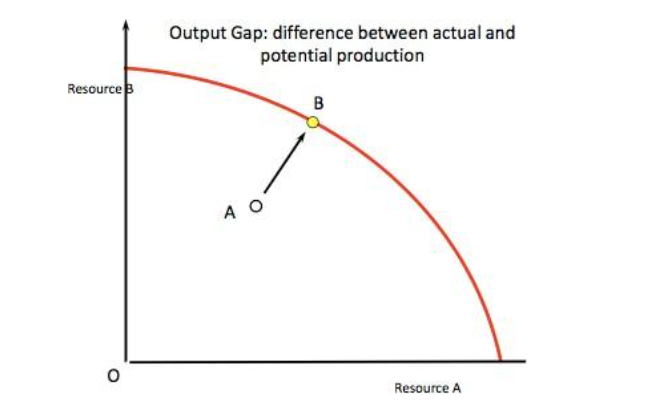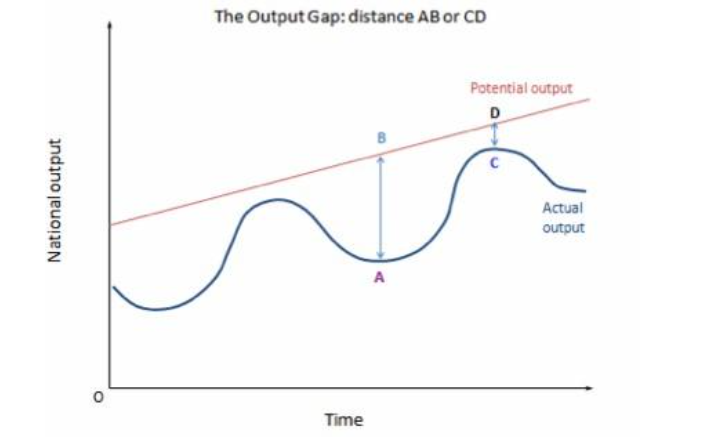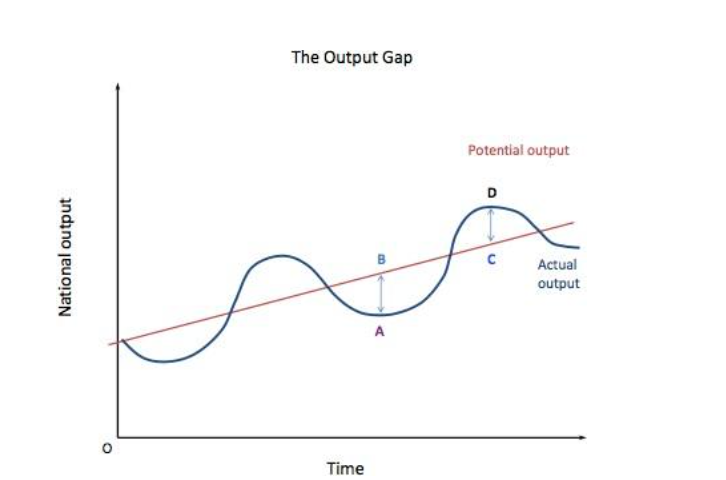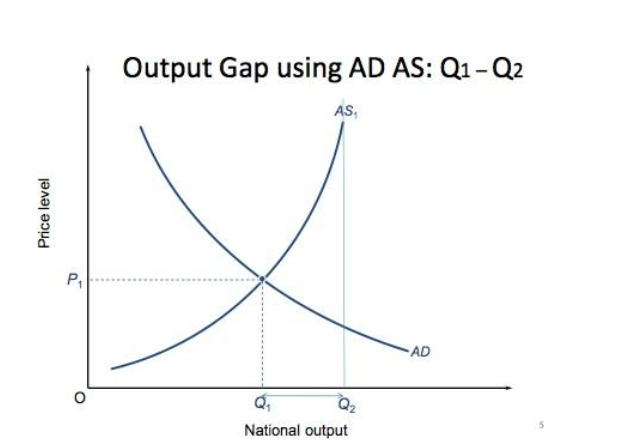Economic Growth - A-Level Economics
Economic Growth: Causes, Costs and Constraints
Actual and Potential Growth
Actual growth is an increase in real GDP
Potential growth is an increase in productive capacity
Trends in Growth Rate
Real GDP growth can be compared to the trend growth:
- During a boom, real GDP rises fast and rises above the trend.
- During a recession, real GDP falls for two consecutive quarters.
- During a slowdown, the level of GDP may be rising, but rising below the trend (disinflation), or the level of GDP might be falling (deflation).
Output Gap
The output gap is the difference between actual output and potential output (the output when the economy is working at maximum efficiency).
A positive output gap occurs when actual output is greater than potential output. This occurs when the economy is growing faster than the trend-‐ it is trying to operate above its potential. This leads to shortages of raw materials and labour, leading to a rise in production and labour costs, and therefore high inflation rates.
A negative output gap occurs when actual output is less than potential output. This occurs when the economy is growing below the trend, and there is likely to be spare capacity in the economy. A negative output gap is characterised by low inflation rates and unemployment.
When the economy is running an output gap, either positive or negative, it is thought to be running at an inefficient rate as the economy is either overworking or underworking its resources.
Different Ways of Drawing the Output Gap




Monetary Policy and the Output Gap
The Monetary Policy Committee (MPC) analyse the output gap when deciding upon interest rates:
- A positive output gap is likely to persuade them to raise interest rates to slow down the economy and reduce inflation.
- A negative output gap is likely to persuade them to lower interest rates to speed up the economy and increase inflation.
Causes of Growth
Causes of actual growth
Actual growth is just an increase in GDP, which is caused by an increase in AD or AS. For example, economies often have export-‐led growth.
However, an increase in AD will only have an effect if the economy is not at full capacity (i.e. the economy is not at the vertical section of the AS curve).
Causes of potential growth
Potential growth can only occur when the AS curve shifts to the right (or the PPF curve shifts outwards), increasing the productive capacity of the economy.
The factors which shift the AS curve are examined in the previous section. In summary, these factors include:
- An increase in quantity and quality* of labour (caused by fall income tax, migration, increased birth rates, improved education and improved healthcare)
* Quality of labour refers to productivity and skill
- An increase in capital stock (caused by investment and technological advancements).
- A reduction in production costs (caused by high exchange rate, fall in cost of raw materials)
N.B. Innovation is also a cause of growth-‐ a thriving enterprising economy is crucial for new business-‐start ups and economic growth.
Constraints of Growth
Several factors limit economic growth:
Absence of Capital Markets
Many small undeveloped countries do not have efficient capital markets. For example, financial capital is not easily available because credit markets are ‘missing’. This is because there is high corruption in many developing countries (especially in Africa), so borrowers do not trust lenders, and therefore charge very high interest rates. This is an example of
asymmetric information-‐ the lender does not know how reliable the borrower is (i.e. there is no credit rating system like there is in developed countries).
Government Instability
In areas where the government are incompetent, corrupt or lack political backing, economic growth is limited. This is because the economy finds it hard to attract investment from abroad, whilst domestic firms are likely to invest abroad instead of within the economy. Also, the currency might be unstable. In some countries, war or political tension add to problems because they damage resources and also use up government money.
Shortage of Skilled Labour
Skilled workers are required for the economy to produce high-‐quality goods that can be sold on the world market. A lack of skilled workers or a lack of workers in general limits the productive capacity of the economy, and hence constraints economic growth.
Benefit of Growth
To Workers
- Increase in real income (🡪 increase in wealth)
- Increase in general standard of living
- Decreases absolute poverty (‘trickle down’ effect)
- Lower unemployment / greater employment opportunities
- Attracts foreign investment, which increases employment opportunities further
- Increase in goods available for consumption
- Increased government funds (via increased tax revenues), so greater investment in public goods (e.g. healthcare, education)
However, an increase in income only results in improved living standards if costs of living do not increase at the same rate.
Arguably, the increase in average income might be just a large increase for wealthy people, whilst poorer people are ‘left behind’. Therefore, living standards do not improve for everyone.
To Firms
- Increased consumer confidence 🡪 increased profits
- Increased business confidence = more investment = improved future growth prospects
- Higher profits which may be used to improve quality of products or produce new products.
To Government
- Increase in income and spending = increased tax revenue = healthier fiscal position , better public services, redistribution of income
- Potential economics growth increases LRAS, which could help lower inflation.
Costs of Growth
Environment
Economic growth leads to a depletion of natural resources and negative externalities such as pollution.
However, economic growth can lead to greater investment in cleaner technologies, such as solar power. Also, growth indicates better efficiency in the economy.
Balance of Payments Problems
With higher incomes, consumers purchase more imports, whilst there is less incentive for firms to export, so a trade deficit will develop.
However, if the growth is export-‐led growth, then the current account will improve.
Income Distribution
Poorer, unskilled workers are less likely to benefit from economic growth. It is likely that the increased incomes go to the wealthier people in society, whilst unskilled workers are left behind.
Economics growth can also lead to transitional change in the economy, which can lead to structural unemployment. Unskilled workers are more likely to be unemployed because they lack adequate skills to adapt to different jobs.
Therefore, growth can lead to increased income inequality.
However, absolute poverty will decrease due to the ‘trickle down’ (wealthier people are earning more, so spend more, leading to more money passing to poor people, e.g. through government benefits).
Lack of Spare Capacity
Economic growth will shift the economy closer to full capacity, and hence factors of production such as skilled labour and raw materials rise in price.
Social Stress
Higher incomes are likely to mean that people are working harder. Workers might have to travel abroad as firms grow. This can arguably put stress on workers in the economy.
However, the higher incomes mean people can afford to work fewer hours, go on more holidays, pay for their children’s education or retire early.
Opportunity Cost of Growth
Opportunity costs of growth include low inflation. Growth has inflationary pressures, so the opportunity cost is the lower inflation rates that could have been achieved.
Another opportunity cost is environmental welfare, as discussed above.
Unsustainable Growth
If growth is too fast it is likely to be unsustainable. Unsustainable growth can mean that high inflation can be followed by a recession due to the boom and bust cycle.
Depletion of the environment will also make growth sustainable, because the over-‐use of scarce resources and land will mean that these resources cannot be used in the future-‐ the growth will not be sustained.
Investment
Firms might not invest the money they receive, but instead distribute profits amongst shareholders.
Evaluating Costs and Benefits
When evaluating effects of growth, be sure to consider:
- Both costs and benefits
- Difficulties of measurement-‐ is economic growth measured accurately?
- Short Run and Long Run-‐ does the economy need some time to settle down before we see the true effect? For example, incomes might seem undistributed at first, but as effects such as the ‘trickle down’ effect begin to take place, the inequality will decrease.
Economic growth refers to an increase in the production and consumption of goods and services in an economy over time. It is often measured by an increase in gross domestic product (GDP), which is the total value of all goods and services produced within a country’s borders.
The main drivers of economic growth include increases in productivity, technological progress, investments in physical and human capital, and improvements in the efficiency of resource allocation.
Economic growth is important because it can lead to improvements in living standards, increased employment opportunities, and a higher standard of living for individuals and societies.
The costs of economic growth can include environmental degradation, income inequality, and the potential for economic instability. The benefits of economic growth can include increased employment opportunities, higher wages, and improvements in the standard of living.
Economic growth refers to an increase in the production and consumption of goods and services, while economic development refers to a broader range of improvements in the quality of life, such as improvements in health, education, and infrastructure.
Government policies can play a significant role in promoting economic growth by encouraging investments in physical and human capital, promoting technological progress, and improving the efficiency of resource allocation. However, policies that are poorly designed or implemented can have negative effects on economic growth.
Businesses can contribute to economic growth by investing in new technologies and capital, expanding into new markets, and creating new jobs. Additionally, businesses can contribute to economic growth by improving the efficiency of resource allocation and increasing productivity.
The main challenges to achieving sustainable economic growth include environmental degradation, income inequality, and the potential for economic instability. Additionally, economic growth may be limited by resource constraints, such as a lack of natural resources or limited access to capital.






Still got a question? Leave a comment
Leave a comment